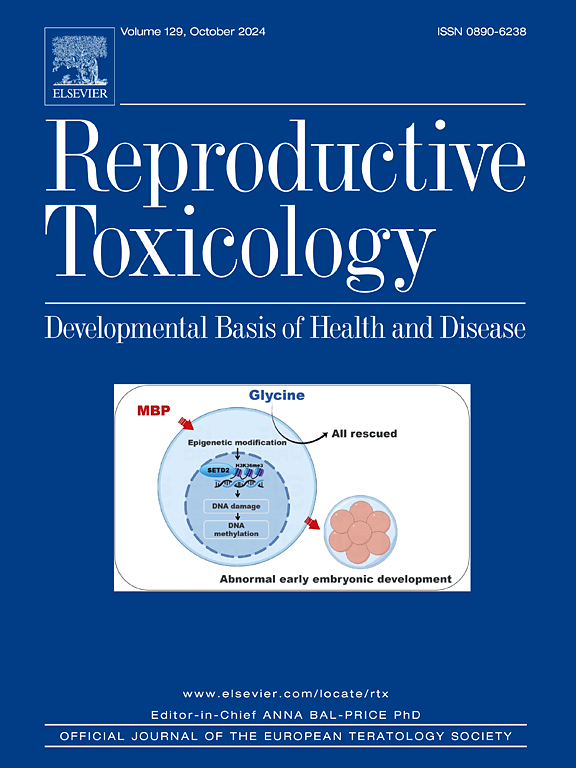Reprotoxic effect of bisphenol F and bisphenol S on female Drosophila melanogaster exposed during development
IF 2.8
4区 医学
Q2 REPRODUCTIVE BIOLOGY
引用次数: 0
Abstract
What is the effect of exposure to Bisphenol F (BPF) and Bisphenol S (BPS) during the embryonic and developmental period on the reproductive system of filial generation 1 (F1) female flies? To answer this question, Drosophila melanogaster were used, which remained throughout the development period, at different concentrations of BPF and BPS (0.25, 0.5, and 1 mM, separately). Upon hatching, evaluation of wing size and body weight, in addition to the expression of the ecdysone receptor (EcR) and enzymes catalase (CAT) and superoxide dismutase (SOD), quantification of reactive species (RS) and CYP 450 activity were performed in part of virgin females (F1). Another part of the females (F1) were mated with untreated males to assess reprotoxicity through tests such as fertility and fecundity, by counting the number of eggs laid and hatched, and evaluation of ovary morphology and viability of ovarian cells. Exposure to 1 mM BPF, 0.5 and 1 mM BPS reduced the ability of flies to lay eggs, changed the shape and size of the ovaries, reduced the viability of ovarian cells, increased body weight, and reduced wing size. EcR reduction was observed at all concentrations, accompanied by an increase of CAT and SOD expression and an increase in CYP450 activity. Even with increases in antioxidant enzymes, the reproductive system of females exposed to 1 mM BPF, 0.5 and 1 mM BPS may have succumbed to the rise in RS and reduction of EcR, which indicates endocrine dysregulation, thus manifesting a reprotoxic effect, highlighting BPS as more harmful.
双酚F和双酚S对雌性黑腹果蝇发育过程中的生殖毒性作用
在胚胎和发育时期暴露于双酚F (BPF)和双酚S (BPS)对子代1 (F1)雌蝇生殖系统的影响?为了回答这个问题,我们使用了在整个发育期间保持不同浓度的BPF和BPS(分别为0.25、0.5和1 mM)的黑胃果蝇。在孵化后,对部分雌性(F1)进行了翅长和体重评估、蜕皮激素受体(EcR)、过氧化氢酶(CAT)和超氧化物歧化酶(SOD)的表达、活性种(RS)和cyp450活性的定量分析。另一部分雌性(F1)与未经处理的雄性交配,通过计算产卵和孵化的数量,以及评估卵巢形态和卵巢细胞的活力等测试来评估生殖毒性。暴露于1 mM BPS、0.5和1 mM BPS会降低果蝇产卵能力,改变卵巢形状和大小,降低卵巢细胞活力,增加体重,缩小翅膀大小。在所有浓度下均观察到EcR降低,并伴有CAT和SOD表达增加和CYP450活性增加。即使抗氧化酶增加,暴露于1 mM BPF、0.5和1 mM BPS的雌性生殖系统也可能屈服于RS升高和EcR降低,这表明内分泌失调,从而表现出生殖毒性作用,突出BPS的危害更大。
本文章由计算机程序翻译,如有差异,请以英文原文为准。
求助全文
约1分钟内获得全文
求助全文
来源期刊

Reproductive toxicology
生物-毒理学
CiteScore
6.50
自引率
3.00%
发文量
131
审稿时长
45 days
期刊介绍:
Drawing from a large number of disciplines, Reproductive Toxicology publishes timely, original research on the influence of chemical and physical agents on reproduction. Written by and for obstetricians, pediatricians, embryologists, teratologists, geneticists, toxicologists, andrologists, and others interested in detecting potential reproductive hazards, the journal is a forum for communication among researchers and practitioners. Articles focus on the application of in vitro, animal and clinical research to the practice of clinical medicine.
All aspects of reproduction are within the scope of Reproductive Toxicology, including the formation and maturation of male and female gametes, sexual function, the events surrounding the fusion of gametes and the development of the fertilized ovum, nourishment and transport of the conceptus within the genital tract, implantation, embryogenesis, intrauterine growth, placentation and placental function, parturition, lactation and neonatal survival. Adverse reproductive effects in males will be considered as significant as adverse effects occurring in females. To provide a balanced presentation of approaches, equal emphasis will be given to clinical and animal or in vitro work. Typical end points that will be studied by contributors include infertility, sexual dysfunction, spontaneous abortion, malformations, abnormal histogenesis, stillbirth, intrauterine growth retardation, prematurity, behavioral abnormalities, and perinatal mortality.
 求助内容:
求助内容: 应助结果提醒方式:
应助结果提醒方式:


